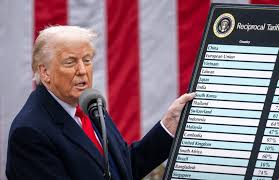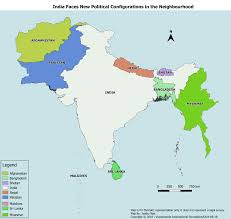The US market cannot be replaceable and India need to adjust to the realities while creating new opportunities in the process
by Ankineedu Prasad Nallapati*
`Reciprocal Tariffs’, announced by President Trump last Wednesday, have now come into force. Markets around the world, including the US, are witnessing a bloodbath with trillions of dollars evaporating every day. US-China spat is spiraling up with the latter facing 104% new tariffs.
Having given the “medicine”, Trump Team now proposes to adjust its “dosage” for relief through negotiations.
No one yet knows where this `Tariff War’, let loose by Trump, leads to.
Some predict a `doomsday’ disrupting the global economic order based on `free trade’ that was painstakingly built after the World War II. They view the American economy perilously close to slipping into recession. Europe is aghast as the transatlantic relationship is unravelling with devastating effect.
What Trump Wants To Achieve
Trump and his cabinet colleagues are gleeful that the global community, friends and foes alike, have started feeling the pain and would soon line up calling on the White House for relief. He is trying to comfort his fellow citizens that hardships faced by them are only temporary and they would soon be enjoying economic boom as country after country start paying obeisance.
However, negotiations on tariffs are not an end in itself as Trump Team sees them only as a means to coerce other countries to correct what they call, “historical imbalances” that have put the US at a disadvantage.
“These tariffs seek to address the injustices of global trade, re-shore manufacturing, and drive economic growth for the American people. They adjust for the unfairness of ongoing international trade practices, balance our chronic goods trade deficit, provide an incentive for re-shoring production to the United States,” Trump stated.
The US global goods trade deficit surged over 40 % to $ 1.2 trillion last year. Its manufacturing output as a share of global production output was 17.4% in 2023, down from 28.4% in 2001. Trump further claimed that his country lost around 5 million manufacturing jobs from 1997 to 2024, experiencing one of the largest drops in manufacturing employment in history.
Do Trump Grievances Make sense?
It’s rather amusing that President Trump plays a `victim’ game while in fact the US, along with its European allies, has always been the global “financial predator”. The US dominance in world financial system and the dollar as reserve currency gave it unparalleled global supremacy.
The contention that the US had a significant loss of jobs due to outsourcing is not based on facts. Employment is consistently growing, increasing from 125 million jobs in 1990 to 167 million in 2023. There may be losses of jobs in automobile manufacturing, but the workers have reskilled themselves to move into other sectors.
The US unemployment has been hovering around 3-5 % during the past three decades, except around the years 2010 and 2019, when it had gone up to 9.6 and 8.06 % respectively. While the first episode was manufactured by the Americans themselves in the form of a financial crisis created by `housing bubble’ and the second was on account of the Covid pandemic.
It has been the Americans and Europeans who are benefitted more from moving some low-level manufacturing units abroad as they could produce goods cheaper and more efficiently with abundant skilled manpower available at low wages and attractive incentives from host nations.
These advantages, combined with lower levies in the US, have helped American administrations to keep domestic prices low for its residents and focus on hi-tech industry.
Internal Skepticism on Trump Wars
While the Democratic Party found a reason to launch protests across the country against Trump’s “faulty” policies, serious disapproval is building up within his own Republican Party and the Wall Street.
Elon Musk, Trump’s top adviser, has taken shots at Peter Navarro, Trade Adviser to the President over the new tariff war and pushed for International economic cooperation and a “zero-tariff situation” between the US and Europe.
A new bill in the Senate to reassert Congressional authority over tariffs has seven Republican co-sponsors.
Sen. Ted Cruz, a Trump ally on the Hill, has warned about the potential economic and political fall out of the tariff policy. Sen. Rand Paul, a right-wing firebrand from the deep red state of Kentucky, cautioned that these policies could lead to a generational political loss for the party.
Top leaders of the Wall Street are also speaking out, including those who have been vocal supporters of Trump, as the markets are melting down day after day. Bill Ackman, the billionaire hedge-fund manager, called for a 90-day pause for the tariffs to negotiate with other countries, warning that the alternative will be a “self-induced, economic nuclear winter.”
US Better Served Targeting Top Trading Partners
Even if some of Trump’s grievances relating to tariffs are true, it would have been better served the US to target its top trading partners rather than the entire `Global South’, whose combined trade with the US has been minimal.
In 2024, the EU was the largest source of imports into US amounting to $605 billion (deficit $236 billion), China $439 billion ($295 b), Japan $148 ($68 b), Vietnam $137 billion ($123 b), South Korea $132 billion ($66b), Taiwan $116 billion ($73b), etc. It was to these countries that American manufacturing industries moved and reaped massive profits.
It’s rather surprising that the Trump Team, instead of targeting few countries that matter and get their trade and other imbalances corrected, choose to shake up small nations that do not count at all in correcting its deficits.
Trade War may Finally Stop at China and EU
The `trade war’ between the US and China is spiraling up as both Trump and Xi Jinping want to push the other to “blink” first.
Beijing announced on April 4 additional tariffs of 34% on all goods produced in the US from April 10 in response to Washington’s `reciprocal’ tariffs of 34% on Chinese goods over and above the 20% levied earlier. It has also announced new limitations on over 18 American companies along with export control measures on certain rare earth-related items.
Trump wasted no time to escalate the tariffs further by another 50%, taking the total to 104%. Xi also may be upping the ante. There are signs of a calibrated devaluation of `Renminbi’ which may prove to be another `red rag’ to Trump.
Who blinks first? We have to wait and see.
The EU member states are meeting on April 9 to vote over a first round of possible retaliation to Trump’s tariffs on steel and aluminum announced last month.
They are however unlikely to present a unified position as they have serious differences.
France and Ireland are lobbying for dropping Bourbon Whiskey from the list of tariffs as Trump threatened 200% tariffs on French wine and champagne in return. There are also differences over how to treat American tech companies.
Italy suggested postponing any counter-tariffs against the US until April 30 to give more time for dialogue.
The EU had earlier proposed to the US a “zero-for-zero” tariff deal on cars and a range of industrial goods, such as pharmaceutical products, rubber and machinery, etc. Its Commissioner for Trade, Maros Sefcovic, said, “The discussions are in early stage, as the US view tariffs not as a tactical step, but as a corrective measure.”.
Where’re We Heading?
While much of the enhanced US tariff rates would be adjusted as nations come down to reduce their rates and open up their markets for American goods. The negotiations are going to be tough as some of Trump’s demands may not be acceptable.
Hopefully, the US team will demonstrate some `realism’ and agree to practical solutions. Others will have to adjust to the new `reality’.
All tariffs are not going to go away as they would be bringing additional revenue to the US which help cover financial deficits. The `base line’ tariff of 10% is here to stay for ever and `reciprocal’ levies are adjusted accordingly.
China and the EU would be playing a tough ball and it is to be seen who proves to be a better negotiator. The EU is a divided house and they would ultimately fall in line to make a deal with Trump.
Xi Jinping, however, cannot afford to be seen bending to Trump and their spat may therefore intensify further before an uneasy truce emerges. This will increase pressure on the global economy and supply-chain movement.
By standing firm against Trump’s push, China seeks to present itself a protector of the rule-based international trading system and take a lead to regroup all those that are hurt by his `tantrums’. Beijing has reached out to the EU and initiated a trilateral economic dialogue with Japan and South Korea.
China has other avenues too like Regional Comprehensive Economic Cooperation (RCEP), a grouping of the ASEAN countries and its FTA partners, China, Australia, Japan, South Korea and New Zealand. China may be acceptable for economic cooperation but its political trust-deficiency may not be bridgeable so easily.
It’s not going to be easy for India too with Trump breathing down its neck despite professing friendship with Prime Minister Modi. The US market, however, cannot be replaced and we need to adjust to the realities while creating new opportunities in the process.
New tariffs on Indian products are relatively modest compared to its competitors like China, Vietnam and other Subcontinental neighbours. This may give better edge to Indian textiles, pharmaceuticals, chemicals, jewelry, agricultural products, etc. This may also prove to be attractive for supply-chains moving out of China and Vietnam.
Other countries of the `global south’ are also expected to be spared of higher tariffs as Trump Team take a new look to assess the outcome of the tariffs.
(*Ankineedu Prasad Nallapati is President of the Hyderabad-based think-tank, `Deccan Council for Strategic Initiatives’, and former Additional Secretary to Govt of India)




